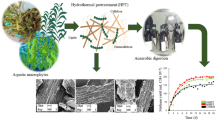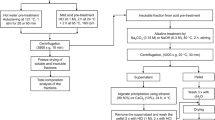Abstract
The outbreak of Ulva prolifera as a marine waste biomass costs a huge amount of manpower and sources for remediation. The effective utilisation of U. prolifera would be mutually beneficial for environmental protection and production of bio-based energy or chemicals. Herein, the pyrolysis behaviour of the main constituents in U. prolifera was investigated to provide valuable data for its further valorisation. The cleavage of thermally unstable sulphated polysaccharides initial occurred between 180 and 200 °C. Uronic acid fraction in hemicellulose degraded at 180–240 °C, releasing formic acid (FA) and oligosaccharides. The complete depolymerisation of hemicellulosic polysaccharides generated rhamnose (Rha) at 300 °C. Above 300 °C, the formation of 5-methyl furfural originated from the dehydration of Rha and the pyrolytic reactions of cellulose. Cellulose with better thermal stability slowly underwent an intermolecular dehydration process at 160 to 240 °C and needed higher temperature for full conversion. The favourable pyrolysis temperature range of the specific constituents and the corresponding detailed pyrolysis characteristics provided an opportunity to obtain value-added chemicals with high selectivity and then increased the utilisation value of U. prolifera.




Similar content being viewed by others
References
Azizi K, Keshavarz MM, Abedini NH (2018) A review on bio-fuel production from microalgal biomass by using pyrolysis method. Renew Sust Energ Rev 82:3046–3059
Balat M (2008) Mechanisms of thermochemical biomass conversion processes. Part 1: reactions of pyrolysis. Energ Source Part A 30:620–635
Bird MI, Wurster CM, de Paula Silva PH, Bass AM, de Nys R (2011) Algal biochar–production and properties. Bioresour Technol 102:1886–1891
Bridgwater AV (2003) Renewable fuels and chemicals by thermal processing of biomass. Chem Eng J 91:87–102
Buelens LC, Galvita VV, Poelman H, Detavernier C, Marin GB (2016) Super-dry reforming of methane intensifies CO2 utilization via Le Chatelier’s principle. Science 354:449–452
Ceylan S, Goldfarb JL (2015) Green tide to green fuels: TG–FTIR analysis and kinetic study of Ulva prolifera pyrolysis. Energy Convers Manag 101:263–270
Ceylan S, Topcu Y, Ceylan Z (2014) Thermal behaviour and kinetics of alga Polysiphonia elongata biomass during pyrolysis. Bioresour Technol 171:193–198
Chang YM, Tsai WT, Li MH (2015) Chemical characterization of char derived from slow pyrolysis of microalgal residue. J Anal Appl Pyrol 111:88–93
Chen YW, Lee HV, Juan JC, Phang S-M (2016) Production of new cellulose nanomaterial from red algae marine biomass Gelidium elegans. Carbohydr Polym 151:1210–1219
Collard FX, Blin J (2014) A review on pyrolysis of biomass constituents: mechanisms and composition of the products obtained from the conversion of cellulose, hemicelluloses and lignin. Renew Sust Energ Rev 38:594–608
Demirbas A (2007) The influence of temperature on the yields of compounds existing in bio-oils obtained from biomass samples via pyrolysis. Fuel Process Technol 88:591–597
Demirbas A (2010) Use of algae as biofuel sources. Energy Convers Manag 51:2738–2749
El Achaby M, Kassab Z, Aboulkas A, Gaillard C, Barakat A (2018) Reuse of red algae waste for the production of cellulose nanocrystals and its application in polymer nanocomposites. Int J Biol Macromol 106:681–691
Gao W, Chen K, Zeng J, Xu J, Wang B (2017) Thermal pyrolysis characteristics of macroalgae Cladophora glomerata. Bioresour Technol 243:212–217
Guerrero P, Etxabide A, Leceta I, Peñalba M, de la Caba K (2014) Extraction of agar from Gelidium sesquipedale (Rhodophyta) and surface characterization of agar based films. Carbohydr Polym 99:491–498
Hu Z, Ma X, Chen C (2012) A study on experimental characteristic of microwave-assisted pyrolysis of microalgae. Bioresour Technol 107:487–493
Hua MY, Li BX (2016) Co-pyrolysis characteristics of the sugarcane bagasse and Enteromorpha prolifera. Energy Convers Manag 120:238–246
Indira P, Biswajit R (2012) Commercial and industrial applications of microalgae-a review. J Algal Biomass Utln 3:89–100
Kazharska M, Ding Y, Arif M, Jiang F, Cong Y, Wang H, Zhao C, Liu X, Chi Z, Liu C (2019) Cellulose nanocrystals derived from Enteromorpha prolifera and their use in developing bionanocomposite films with water-soluble polysaccharides extracted from E. prolifera. Int J Biol Macromol 134:390–396
Kunov-Kruse AJ, Riisager A, Saravanamurugan S, Berg RW, Kristensen SB, Fehrmann R (2013) Revisiting the Brønsted acid catalysed hydrolysis kinetics of polymeric carbohydrates in ionic liquids by in situ ATR-FTIR spectroscopy. Green Chem 15:2843–2848
Li D, Chen L, Zhao J, Zhang X, Wang Q, Wang H, Ye N (2010) Evaluation of the pyrolytic and kinetic characteristics of Enteromorpha prolifera as a source of renewable bio-fuel from the Yellow Sea of China. Chem Eng Res Des 88:647–652
Li B, Liu S, Xing R, Li K, Li R, Qin Y, Wang X, Wei Z, Li P (2013) Degradation of sulfated polysaccharides from Enteromorpha prolifera and their antioxidant activities. Carbohydr Polym 92:1991–1996
Li H, Li L, Zhang R, Tong D, Hu C (2014) Fractional pyrolysis of cyanobacteria from water blooms over HZSM-5 for high quality bio-oil production. J Energy Chem 23:732–741
Li L, Zhang R, Tong D, Hu C (2015) Fractional pyrolysis of algae and model compounds. Chin J Chem Phys 28:525–532
Ma Y, Wang J, Zhang Y (2018) TG-FTIR study on pyrolysis of Enteromorpha prolifera. Biomass Convers Bior 8:151–157
Marcilla A, Catalá L, García-Quesada JC, Valdés FJ, Hernández MR (2013) A review of thermochemical conversion of microalgae. Renew Sust Energ Rev 27:11–19
Miller FA, Wilkins CH (1952) Infrared spectra and characteristic frequencies of inorganic ions. Anal Chem 24:1253–1294
Montingelli ME, Tedesco S, Olabi AG (2015) Biogas production from algal biomass: a review. Renew Sust Energ Rev 43:961–972
Nelson WL, Engelder CJ (1925) The thermal decomposition of formic acid. J Phys Chem 30:470–475
Pandey KK (1999) A study of chemical structure of soft and hardwood and wood polymers by FTIR spectroscopy. J Appl Polym Sci 71:1969–1975
Peng W, Wu Q, Tu P, Zhao N (2001) Pyrolytic characteristics of microalgae as renewable energy source determined by thermogravimetric analysis. Bioresour Technol 80:1–7
Peng F, Ren JL, Xu F, Bian J, Peng P, Sun RC (2010) Comparative studies on the physico-chemical properties of hemicelluloses obtained by DEAE-cellulose-52 chromatography from sugarcane bagasse. Food Res Int 43:683–693
Ray B (2006) Polysaccharides from Enteromorpha compressa: isolation, purification and structural features. Carbohydr Polym 66:408–416
Rees NV, Compton RG (2011) Sustainable energy: a review of formic acid electrochemical fuel cells. J Solid State Electr 15:2095–2100
Tang J, Zhu L, Fu X, Dai J, Guo X, Hu C (2017) Insights into the kinetics and reaction network of aluminum chloride-catalyzed conversion of glucose in NaCl–H2O/THF biphasic system. ACS Catal 7:256–266
Van de Velden M, Baeyens J, Brems A, Janssens B, Dewil R (2010) Fundamentals, kinetics and endothermicity of the biomass pyrolysis reaction. Renew Energy 35:232–242
van Putten R-J, van der Waal JC, de Jong E, Rasrendra CB, Heeres HJ, de Vries JG (2013) Hydroxymethylfurfural, a versatile platform chemical made from renewable resources. Chem Rev 113:1499–1597
Wang S, Ru B, Lin H, Sun W (2015) Pyrolysis behaviors of four O-acetyl-preserved hemicelluloses isolated from hardwoods and softwoods. Fuel 150:243–251
Wang S, Dai G, Yang H, Luo Z (2017a) Lignocellulosic biomass pyrolysis mechanism: a state-of-the-art review. Prog Energy Combust 62:33–86
Wang S, Hu Y, Uzoejinwa BB, Cao B, He Z, Wang Q, Xu S (2017b) Pyrolysis mechanisms of typical seaweed polysaccharides. J Anal Appl Pyrol 124:373–383
Wang X, Sheng L, Yang X (2017c) Pyrolysis characteristics and pathways of protein, lipid and carbohydrate isolated from microalgae Nannochloropsis sp. Bioresour Technol 229:119–125
Wang Y, Liu F, Liu X, Shi S, Bi Y, Moejes FW (2019) Comparative transcriptome analysis of four co-occurring Ulva species for understanding the dominance of Ulva prolifera in the Yellow Sea green tides. J Appl Phycol 31:3303–3316
Wu K, Liu J, Wu Y, Chen Y, Li Q, Xiao X, Yang M (2014) Pyrolysis characteristics and kinetics of aquatic biomass using thermogravimetric analyzer. Bioresour Technol 163:18–25
Yang H, Yan R, Chen H, Lee DH, Zheng C (2007) Characteristics of hemicellulose, cellulose and lignin pyrolysis. Fuel 86:1781–1788
Yang C, Li R, Zhang B, Qiu Q, Wang B, Yang H, Ding Y, Wang C (2019) Pyrolysis of microalgae: a critical review. Fuel Process Technol 186:53–72
Yu KL, Lau BF, Show PL, Ong HC, Ling TC, Chen W-H, Ng EP, Chang J-S (2017) Recent developments on algal biochar production and characterization. Bioresour Technol 246:2–11
Yuan X, Zheng J, Ren L, Jiao S, Feng C, Du Y, Liu H (2019) Enteromorpha prolifera oligomers relieve pancreatic injury in streptozotocin (STZ)-induced diabetic mice. Carbohydr Polym 206:403–411
Zhang R, Li L, Tong D, Hu C (2016) Microwave-enhanced pyrolysis of natural algae from water blooms. Bioresour Technol 212:311–317
Zhang R, Chen Y, Zhou Y, Tong D, Hu C (2019) Selective conversion of hemicellulose in macroalgae Enteromorpha prolifera to rhamnose. ACS Omega 4:7023–7028
Zhao H, Yan H, Liu M, Zhang C, Qin S (2011) Pyrolytic characteristics and kinetics of the marine green tide macroalgae, Enteromorpha prolifera. Chin J Oceanol Limnol 29:996–1001
Zhao H, Yan HX, Liu M, Zhang CW, Sun BB, Dong SS, Qin S (2012) The pyrolysis characteristics and kinetics of the marine macroalgae Enteromorpha prolifera using a thermogravimetric analyzer. Energ Source Part A 34:1958–1966
Zhao H, Yan HX, Liu M, Sun BB, Zhang Y, Dong SS, Qi LB, Qin S (2013) Production of bio-oil from fast pyrolysis of macroalgae Enteromorpha prolifera powder in a free-fall reactor. Energ Source Part A 35:859–867
Acknowledgements
The Analytical and Testing Center of Sichuan University is greatly acknowledged for the characterisation of materials.
Funding
This work was supported by the National Key R&D Program of China (2018YFB1501404), the 111 program (B17030), and Fundamental Research Funds for the Central Universities.
Author information
Authors and Affiliations
Corresponding author
Additional information
Publisher’s note
Springer Nature remains neutral with regard to jurisdictional claims in published maps and institutional affiliations.
Electronic supplementary material
Supplementary Material
. The following additional data can be found in Online Resource: The TG-DTG curve of U. prolifera; Product yields of pyrolytic U. prolifera at 160–240 °C. (DOCX 168 kb)
Rights and permissions
About this article
Cite this article
Zhang, R., Zhou, Y. & Hu, C. Study on the pyrolysis behaviour of the macroalga Ulva prolifera. J Appl Phycol 33, 91–99 (2021). https://doi.org/10.1007/s10811-020-02157-6
Received:
Revised:
Accepted:
Published:
Issue Date:
DOI: https://doi.org/10.1007/s10811-020-02157-6




